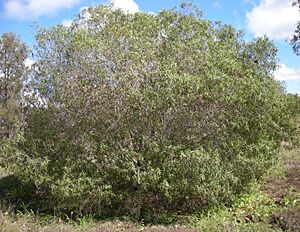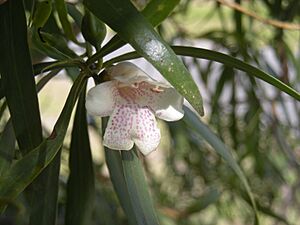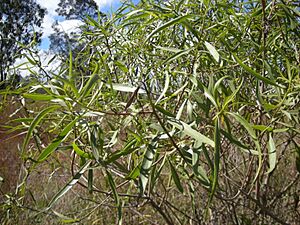Bignonia emu bush facts for kids
Quick facts for kids Bignonia emu bush |
|
|---|---|
 |
|
| Scientific classification | |
| Genus: |
Eremophila (plant)
|
| Species: |
bignoniiflora
|
| Synonyms | |
|
|
The Eremophila bignoniiflora, also known as Bignonia emu bush, is a special plant. People also call it creek wilga, dogwood, eurah, gooramurra, kurumbimi (in Jingulu and Mudburra languages), and river argee. It belongs to the figwort family called Scrophulariaceae. This plant grows naturally in the Northern Territory and all other mainland states of Australia.
It is a shrub or small tree that spreads out and has branches that hang down. Its leaves are long and look like straps. The leaves of the Bignonia emu bush are among the longest in the Eremophila genus (a group of similar plants). Its flowers are also quite big. This is because birds help to pollinate them.
Contents
What Does the Bignonia Emu Bush Look Like?
The Bignonia emu bush is a spreading shrub or a small tree. It usually has many branches that hang down. It can grow to be about 1 to 8 metres (3 to 26 feet) tall. Sometimes, it can be almost as wide as it is tall.
Older plants have a thick trunk. Their bark is pale brown and has small holes. The leaves grow one after another along the branches. They are usually 110 to 160 millimetres (4 to 6 inches) long. They are also about 4 to 9 millimetres (0.2 to 0.4 inches) wide. The leaves are long and narrow, like a spear, and get thinner at both ends. Sometimes, the edges of the leaves have a few small teeth near the tip.
The flowers grow one by one where the leaves join the stem. They are on a straight stalk that is usually 9 to 18 millimetres (0.4 to 0.7 inches) long. Each flower has 5 green sepals. Sepals are like small leaves that protect the flower bud. These sepals are egg-shaped and pointed. They have a clear ridge in the middle and are about 5 to 6.5 millimetres (0.2 to 0.3 inches) long.
The petals are 20 to 30 millimetres (0.8 to 1.2 inches) long. They join together at their bottom to form a tube. This petal tube is creamy white. It has crimson (dark red) spots, mostly on the lower part of the flower and inside the tube. There are 4 stamens, which are the parts that make pollen. They are about the same length as the petal tube.
The flowers usually appear between May and August. After the flowers, the plant grows fruit. These fruits are dry and oval-shaped. They are about 20 to 30 millimetres (0.8 to 1.2 inches) long.
How the Bignonia Emu Bush Got Its Name
The first scientific description of this plant was made by a botanist named George Bentham in 1848. He called it Stenochilus bignoniiflorus. This description was published in a book about an expedition into tropical Australia.
Later, in 1859, another botanist named Ferdinand von Mueller changed the name to Eremophila bignoniiflora. The second part of the name, bignoniiflora, means that its flowers look similar to plants in the Bignoniaceae family.
Where Does the Bignonia Emu Bush Grow?
The Bignonia emu bush grows widely in New South Wales and Queensland. You can also find it in the far north-east of South Australia and the very north-west part of Victoria. There are also some groups of these plants scattered in the Northern Territory and northern Western Australia. These are found between Derby and Halls Creek.
This plant often grows in the flat areas around big rivers. Sometimes, you can find single plants in other places too.
How Does the Bignonia Emu Bush Interact with Nature?
The flowers of the Bignonia emu bush are pollinated by birds. This means birds help the plant make seeds by carrying pollen from one flower to another.
Is the Bignonia Emu Bush Protected?
The government of Western Australia's Department of Parks and Wildlife says this species is "not threatened." This means it is not in danger of disappearing there. However, in Victoria, it is listed as "vulnerable" under the Flora and Fauna Guarantee Act 1988. This means it needs protection in Victoria because its numbers might be decreasing.
Uses of the Bignonia Emu Bush
Traditional Uses by Indigenous Australians
Aboriginal people used the gooramurra plant as a traditional medicine. Scientists have studied oils taken from the plant. They found that these oils can fight against certain germs. For example, they were effective against a type of yeast called Candida albicans and a bacterium called Staphylococcus epidermidis.
Growing Bignonia Emu Bush in Gardens
The Bignonia emu bush is a popular plant to grow in gardens. You can find it in gardens from the southern coast of Victoria and Sydney all the way to central Queensland. It is a good plant to use if you want to create a screen in dry areas. It can also be a beautiful feature plant in a garden.
It can be a bit tricky to grow new plants from cuttings. However, you can grow it from seeds. You can also graft it onto another plant called Myoporum. It grows best in full sun and soil that drains water well. If the soil is clay, the plant will be smaller and less dense. This plant is very good at handling dry weather. It can also recover from frost, especially when it is a mature plant.
See also
 In Spanish: Bignonia emú para niños
In Spanish: Bignonia emú para niños




